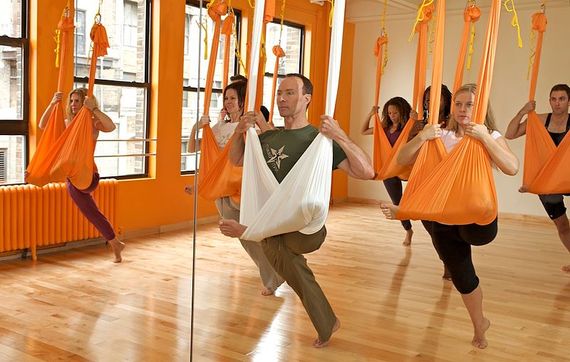If you like yoga -- even if you don't do it that often -- you should definitely, certainly, positively consider giving Aerial Yoga a try.
For me, aerial yoga was like normal yoga... times 10. Not times 10 in terms of difficulty, but in terms of how effective, fulfilling and calming it was.
Here's how it works: You sit on a soft, fabric hammock that looks kind of like a long scarf. These hammocks are made out of special, high-density nylon material that can support over 2,000 pounds, so don't worry - you're not going to tear them.
The hammocks are held up by carabineers, support chains and webbing straps. You can adjust the height according to personal preference, or for better maneuverability. (Note: You'll also want to bring your normal yoga mat to an aerial yoga class so you have something to stand on.)
Throughout the yoga class, you do various traditional yoga poses or aerial adaptations of traditional poses using the hammock for support.
Some of the most basic poses involve simple stretches while seated on the hammock, while other poses progress to hanging upside down and grabbing your thighs, ankles or feet for support and balance.
Why Aerial Yoga?
Aerial yoga offers many of the same benefits and enjoyments of regular yoga, but it also has some additional benefits as well:
Greater Flexibility. Since you have more freedom of movement, you can move your body into new positions. In some cases, this can result in a deeper and more fulfilling stretch than traditional yoga offers.
Better Focus. By putting yourself in a more challenging situation than usual, aerial yoga forces you to be more alert and aware of your surroundings. You will likely also try to concentrate harder because you're not used to being suspended in the air during your yoga practice.
Strengthened Muscles. Because gravity is working harder on your body than usual, your muscles work harder too. Aerial yoga is also a great core workout because you have to engage your core muscles to balance and stabilize yourself during your yoga session.
Stress-Relief. Much like traditional yoga, aerial yoga is great for stress relief. Not only do you use poses and stretches common to other forms of yoga to relieve stress, but you also experience the joy of knowing that you did something new and exciting, which makes you feel good.
Of course, any kind of physical exercise poses some risk of injury. So what are the risks associated with aerial yoga?
Is Aerial Yoga Safe?
Aerial yoga is a safe form of exercise in that all aerial yoga classes should be taught by a certified aerial yoga instructor (you can specifically ask your yoga facility about your instructor's qualifications before taking an aerial class). Your instructor will be able to tell you how to perform aerial poses properly, so that you don't injure yourself.
Furthermore, you are only suspended three or so feet from the ground during aerial classes (although you can adjust the height of your hammock to suit your needs or make the class more challenging). Therefore, the risk of injuring yourself from falling is quite minimal.
Some considerations to take into account, however, are the multiple risks associated with hanging upside down for too long. Of course, no reputable yoga instructor is going to keep you upside down for longer than is healthy, but you should be aware of the health risks associated with this activity nonetheless.
Most people can engage in aerial yoga with few to no problems. However, if any of the following apply to you, you should consider a different form of exercise or -- at the very least -- consult with your doctor and yoga instructor before trying an aerial class:
- Pregnancy
- Eye diseases
- Recent eye surgery
- Vertigo
- Cardiovascular diseases
- Bone disorders
- High/Low blood pressure
- Prosthetic hips
- Colds/Flu/Any condition that blocks the nasal passages
For those of you who have decided to give this unique form of exercise a try, here are some tips to help you avoid accidents and injuries in your first class:
Wear form-fitting, but comfortable, clothes. Loose or baggy clothing can make it difficult to move and has the potential to get snagged or tangled in the hammock's mechanisms.
Go barefoot. You'll feel more comfortable moving around in the hammock this way.
Drink plenty of water, and eat a light meal. This will prepare you for the intensity of the workout ahead.
Avoid soft drinks and other acidic liquid before class. These might cause unpleasant feelings in your gut when performing the upside-down movements.
Do not use hand lotion. It might stick to the hammock, or make it harder for you to maintain your grip.
Remove jewelry, watches and anything else that can rip into or get tangled in the hammock. This also includes untrimmed fingernails and toenails.
Be considerate toward your instructor and classmates. If you have good relationships with them, they're more likely to give you help when you need it.
Don't go at it alone. Unless you're 100 percent sure of your aerial yoga skills, you'll be much safer performing with others.
Aerial yoga might seem like an intimidating exercise at first but it can be incredibly rewarding and exciting. Many fitness clubs offer aerial classes for people of all fitness and skill levels. Check into the aerial options in your area, and you just might discover your favorite form of exercise yet.
Image by ESerranoAG via Wikipedia Commons
